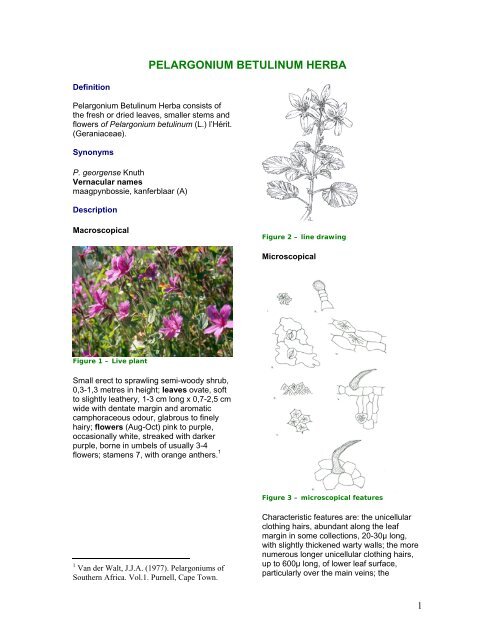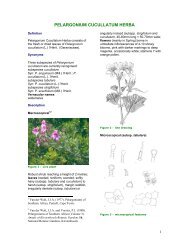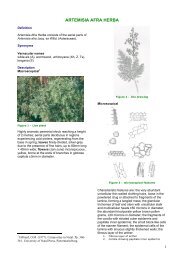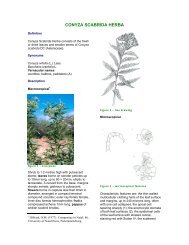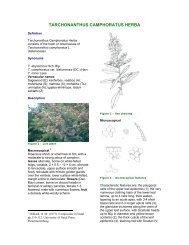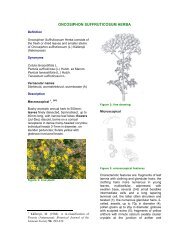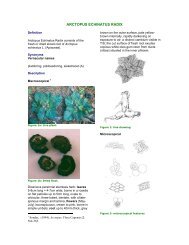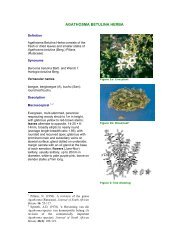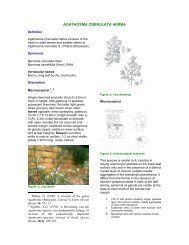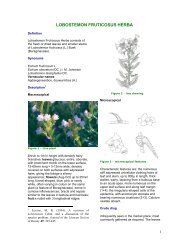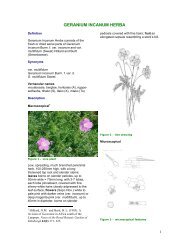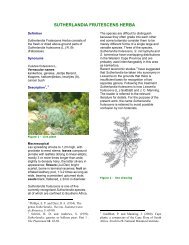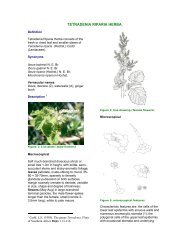PELARGONIUM BETULINUM HERBA - PlantZAfrica
PELARGONIUM BETULINUM HERBA - PlantZAfrica
PELARGONIUM BETULINUM HERBA - PlantZAfrica
Create successful ePaper yourself
Turn your PDF publications into a flip-book with our unique Google optimized e-Paper software.
Definition<br />
<strong>PELARGONIUM</strong> <strong>BETULINUM</strong> <strong>HERBA</strong><br />
Pelargonium Betulinum Herba consists of<br />
the fresh or dried leaves, smaller stems and<br />
flowers of Pelargonium betulinum (L.) l’Hérit.<br />
(Geraniaceae).<br />
Synonyms<br />
P. georgense Knuth<br />
Vernacular names<br />
maagpynbossie, kanferblaar (A)<br />
Description<br />
Macroscopical<br />
Figure 1 – Live plant<br />
Small erect to sprawling semi-woody shrub,<br />
0,3-1,3 metres in height; leaves ovate, soft<br />
to slightly leathery, 1-3 cm long x 0,7-2,5 cm<br />
wide with dentate margin and aromatic<br />
camphoraceous odour, glabrous to finely<br />
hairy; flowers (Aug-Oct) pink to purple,<br />
occasionally white, streaked with darker<br />
purple, borne in umbels of usually 3-4<br />
flowers; stamens 7, with orange anthers. 1<br />
1 Van der Walt, J.J.A. (1977). Pelargoniums of<br />
Southern Africa. Vol.1. Purnell, Cape Town.<br />
Figure 2 – line drawing<br />
Microscopical<br />
Figure 3 – microscopical features<br />
Characteristic features are: the unicellular<br />
clothing hairs, abundant along the leaf<br />
margin in some collections, 20-30µ long,<br />
with slightly thickened warty walls; the more<br />
numerous longer unicellular clothing hairs,<br />
up to 600µ long, of lower leaf surface,<br />
particularly over the main veins; the<br />
1
glandular hairs with multicellular stalks and<br />
unicellular heads ±20µ in diameter, with redbrown<br />
contents; the abundant rosette<br />
aggregates of calcium oxalate, 40-50µ in<br />
diameter, forming a crystal layer in the leaf<br />
mesophyll or occurring loose in the<br />
powdered drug; the fairly abundant<br />
triaperturate yellow-brown pollen grains, up<br />
to 80µ in diameter; the papillate cells of the<br />
corolla epidermis; the polygonal to slightly<br />
wavy walled cells of upper and lower leaf<br />
epidermis; the cells of the palisade layer<br />
with red-brown contents.<br />
1. Calcium oxalate rosette aggregate<br />
(40-50µ diameter)<br />
2. Glandular trichome with unicellular<br />
head ±20µ in diameter, with redbrown<br />
contents<br />
3. Leaf epidermis with anomocytic<br />
stomata<br />
4. Papillate cells of leaf epidermis<br />
5. Papillate cells of corolla epidermis<br />
(lateral view)<br />
6. T/S leaf showing clothing hair and<br />
calcium oxalate rosette aggregate in<br />
cell of mesophyll<br />
Crude drug<br />
Supplied in bundles comprising young leaf<br />
and stem, sometimes together with flowers;<br />
odour pleasantly aromatic and camphor-like;<br />
dried powdered drug distinctly red brown in<br />
colour.<br />
Geographical distribution<br />
Sandy dunes and coastal flats of the<br />
Western Cape Province.<br />
Figure 4 – distribution map<br />
Quality standards<br />
Identity tests<br />
Figure 5 – TLC plate<br />
Thin layer chromatography on silica gel<br />
using as solvent a mixture of toluene:diethyl<br />
ether:1.75M acetic acid (1:1:1). Reference<br />
compound cineole (0,1% in chloroform).<br />
Method according to Appendix 2a.<br />
Rf values of major compounds: 0,48 (lilac);<br />
0,63 (light sage green); 0,69 (sage green);<br />
0.74 (sage green); 0.85 (lilac); cineole: 0,69<br />
(blue-purple)<br />
HPLC on C18 column, method according to<br />
Appendix 2b.<br />
Figure 6 – HPLC spectrum<br />
2
Major compounds:<br />
Methanol extract: (Figure 6)<br />
Retention times (mins): 19.81; 20.22; 20.73;<br />
21.27<br />
Ethanol (70%) soluble extractive value:<br />
not less than 28% (range: 28.27-31.34%)<br />
Purity tests<br />
Assay<br />
Not yet available<br />
Major chemical constituents<br />
Figure 7 – chemical constituents<br />
Microchemical tests in our laboratories<br />
indicated the presence in this species of<br />
saponins and tannins but not alkaloids,<br />
cardiac glycosides, cyanogens or<br />
anthraquinone derivatives.<br />
Coumarins e.g. 7-hydroxy-5, 6dimethoxycoumarin<br />
(umckalin), its 7glucoside<br />
and scopoletin have been<br />
identified as major constituents of root<br />
extracts of P. betulinum as well as of 11<br />
other Pelargonium species 2 but do not<br />
appear to characterise the above-ground<br />
organs of the genus. Tannins (hydrolysable<br />
+ condensed) and flavonoids, rather than<br />
coumarins, appear to be the major<br />
secondary constituents of leaf, flower and<br />
stem 3 . The indole alkaloids elaeocarpidine<br />
and its 20-H isomer epielaeocarpidine have<br />
2 Wagner, H. and Bladt, S. (1975). Coumarins<br />
from South African Pelargonium species.<br />
Phytochemistry 14:2061-2064.<br />
3 Latté, K-P. (1999). Phytochemische und<br />
pharmacologische Untersuchungen an<br />
Pelargonium reniforme Curt. PhD thesis,<br />
University of Berlin.<br />
been identified in leaves of 8 Pelargonium<br />
species but not in those of P. betulinum 4<br />
Essential oils characterise species of<br />
Pelargonium Section Pelargonium, to which<br />
Pelargonium betulinum belongs, but little is<br />
known at present of the composition of P.<br />
betulinum oil, or of other constituents of this<br />
species.<br />
Dosage forms<br />
Used mainly in the form of an aqueous<br />
infusion, taken internally. The vapours<br />
obtained from steaming the leaves in boiling<br />
water may be inhaled.<br />
Medicinal uses<br />
As the vernacular name suggests, infusions<br />
of this herb are used to treat colic and<br />
gastric disorders; inhalation of the vapours<br />
obtained from steaming the leaf is<br />
considered beneficial for cough and<br />
bronchial congestion.<br />
Pharmacology/bioactivity<br />
Little is known of the pharmacology of this<br />
species. Preliminary assays indicated no in<br />
vitro antimicrobial activity of aqueous<br />
extracts against Pseudomonas aeruginosa,<br />
Candida albicans or Mycobacterium<br />
smegmatis in the concentrations used in our<br />
laboratories. Some activity was recorded<br />
against Staphylococcus aureus.<br />
Scientific interest in the bioactivity of the<br />
genus Pelargonium has focused mainly on<br />
P. reniforme and P. sidioides, the roots of<br />
which are used traditionally to treat<br />
diarrhoea. Under the vernacular name<br />
umkcaloabo, their recommended use as a<br />
specific for tuberculosis, bronchitis and other<br />
pulmonary disorders attracted the attention<br />
of the German pharmaceutical industry and<br />
a herbal preparation known as Umckaloabo<br />
® (ISO, Regensberg) has been available for<br />
some years. Antibacterial, antimycobacterial,<br />
and immunomodulatory<br />
4 Lis-Balchin, M.T. (1996). A chemotaxonomic<br />
reappraisal of the Sectionn Ciconium<br />
Pelargonium (Geraniaceae). South African<br />
Journal of Botany 62(5): 277-279.<br />
3
activity of whole plant extracts and of<br />
isolates has been investigated 2 .<br />
Contraindications<br />
None known.<br />
Adverse reactions<br />
None reported.<br />
Precautions<br />
No special precautions.<br />
Dosage<br />
Eight tablespoonsful (±20g) of dried<br />
powdered herb is infused until cold in one<br />
litre (± 6 teacupfuls) of boiling water. The<br />
mixture is strained and taken in half<br />
teacupful (90ml) doses three times daily. For<br />
nasal or bronchial congestion, fresh leaf<br />
should be added to a basin of boiling water<br />
and the vapours inhaled.<br />
Copyright in this monograph resides with the authors, the South<br />
African National Biodiversity Institute, the South African Medical<br />
Research Council and the University of the Western Cape. It may<br />
not be reproduced in whole or in part without the written consent of<br />
the copyright holders.<br />
4


